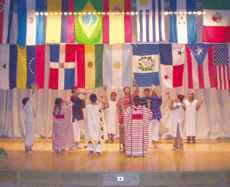From Fiesta to Siesta

Campus Unions Prepare Vote of No Confidence
November 13, 2002
It was a busy week indeed for Casa Latina as they prepared for and performed in the Seventh Annual Latino Multicultural Festival, the culminating event of a week-long celebration of Latin American culture (November 4- 8). Casa Latina is, in their words, “a diverse Latino student-run organization dedicated to creating community at the University of Massachusetts for Latinos and other students through social, cultural, educational, and other activities that foster the development of leadership among Latino students in [the] University of Massachusetts Boston.”
The evening began with an acapella performance of “Mi Bella Quisqueya,” done by Michael Abreu to warm up the audience. Harmonious and soaring in his passion for his music, his voice was strong enough to be heard. The addition of the microphone left listeners partly deaf since some notes were piercing to the eardrums.
Although the festival was supposed to be open to all students, it was difficult for anyone attending the Friday evening, November 8 multicultural show because many of the announcements were in Spanish with a very weak effort at translation, so that any unfamiliar with the language were left in the dark. It is unfortunate, as it would have made more of an impact if some observers were capable of following what was being said.
The play, “El Circulo de Mi Gente” (“Circle of My People”), was a shaky excuse for showcasing various aspects of Latin culture. Each part tried to give some example of different facets of the culture, such as flamenco or “indigenous” dances, contained within the meager framework constituting a plot.
Scene I, “People of the Land,” featured an energetic “Indigenous Dance” complete with clattering shells, trumpeting conches, pounding drums, and young children in traditional dress.
However, the scene shifted to two young native children playing with a ball, or as referred to by the narrator as “the object,” with their father standing tall and proud in his paternal role.
Scene II showed people dressed in black, acting as the “Spanish Conquerors,” pick up the children and run offstage while the narrator kept mentioning “the object” over and over again when he even chose to speak.
However, the flamenco dance was clearly performed by an experienced dancer. Clad in reddish-orange dress, a woman sang with a young man accompanying her on the guitar as the dancer stomped her chunky platform heels and slowly built up the suspense leading the audience with her as she moved from sassy to explosively sensual.
Flamenco is seen as a dance but really encompasses three elements: the guitar, the song, and the dance. It originates from the Andalusia region of Spain and, like the American blues, was first used to express sadness and frustration until it evolved to include happiness and love as well.
The narrator performed via voice-over, often spacing his words several seconds to a few minutes apart. It was confusing to try and figure out if he was ending a sentence or beginning a new thought. After a while, it just ended up being annoying.
Scene III, “Revolution,” involved a traditional Haitian dance performed by three young women while Scene IV, “Latinos/Latinas in the USA,” showed a female student of Latin descent finally understanding that the aforementioned “object” was the culture and heritage she carried within her. She realized that she was descended from the slaves, the conquerors, and the conquered. Scene IV stood out the most because of its two well-choreographed couples performing salsa and meringue numbers.
Though the festival was not as polished as it could have been, it did include many elements of Latin culture, and made a point as to how all-inclusive society is in the many different ways of life it encompasses. The costuming and dances involved no small effort on behalf of the performers and should be acknowledged. One sloppy night out of a week of successes isn’t the worst.




















































